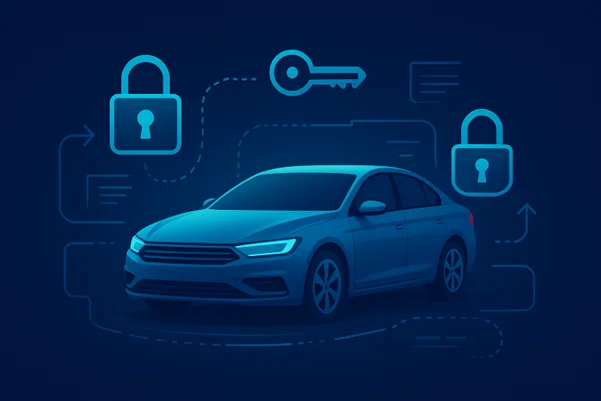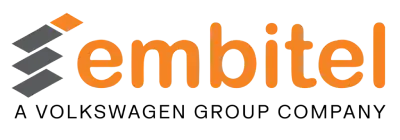A software defined vehicle today is no less than an obedient robot that follows all your commands. While all of us are quite aware of this reality, in the background dozens of ECUs communicate across complex in-vehicle networks and external interfaces that makes this possible.
However, just like any other connected device ECUs are among the most vulnerable components targeted by cyber attackers to jeopardize your vehicle safety .
So, the question here is how do we ensure the ECU security, right?
Well each of these ECUs relies on authentication, encryption, and real-time validation ensured via digital certificates. These certificates act as the backbone of secure communication assigning a unique identity validated before any data exchange.
Moreover, to ensure its efficient functioning a whole ecosystem known as certificate-based Public Key Infrastructure (PKI) is put in use. It establishes a structured framework for securing digital identities and their communication across the vehicle lifecycle.
Certificates typically do not act as identifiers on their own, instead, they bind an identity such as an ECU, a vehicle, or a backend service to a public key, with a trusted Certificate Authority validating the relationship. This mechanism enables endpoints to mutually authenticate, encrypt both internal and external communications, and ensure the integrity of software updates.
While this functionality looks straightforward, the complexity in management surfaces at scale, managing millions of certificates across global fleets. This article explores the major challenges of automotive certificate management at scale and outlines scalable practices for OEMs and suppliers to maintain trust across vehicles, ECUs, and backend systems.
Common Challenges in Automotive Certificate Management

Within a secure network system like that of automobiles, certificate management is much different. Unlike enterprise PKI, automotive environments face additional constraints such as long product lifecycles, limited connectivity, real-time performance demands, and heterogeneous suppliers.
These unique constraints make automotive certificate management far more intricate in practice, leading to a range of engineering challenges that must be addressed systematically.
Key Ownership Across the Supply Chain
- Device Identity Certificates, where each ECU owns a private key and is provisioned with a corresponding certificate binding its public key to an identity. These are used for TLS, backend authentication, and in-vehicle communication.
- Verification Keys for Secure Boot and Firmware Validation, where the private key remains under OEM control (inside the signing infrastructure or PKI), and only the public verification key (or its certificate) is provisioned into the ECU. This allows the ECU to verify the authenticity of signed software images before boot or update.
- Manufacturing Execution Systems (MES) to handle per-device identity provisioning (key pair generation, CSR signing, logging, VIN binding).
- Software Release Infrastructure to handle signing keys and certificate chains used for image authentication.
- ECUs that authenticate themselves receive certificates issued against their local key pair.
- ECUs that verify authenticity receive a trusted public key chain linked to the OEM’s signing CA.
Device Identity Certificate Provisioning & Enrolment
- ECU generates its key pair inside the secure element
- ECU creates a CSR containing only the public key and sends to the CA
- The CA signs and returns the device certificate and chain to the ECU
- The ECU stores the private key sealed in hardware and stores the associated certificate and its trust chai
Certificate Lifecycle Synchronization
- Attempting a full CRL or OCSP validation over a low-bandwidth CAN bus can fail, with revoked certificates trusted in-vehicle.
- Misaligned certificate rotation between ECUs can further break TLS or SecOC channels, leading to cross-ECU authentication failures.
- Drifted intermediate CAs or inconsistent timestamps among supplier ECUs can propagate trust mismatches across domains.
OTA Trust Anchors & Secure Update Protocols
Automotive PKI supports two distinct trust directions:
Challenge: Coordinating the Supplier Models
Coordinating these two models across a fragmented supplier ecosystem is a major challenge. Some ECUs require identity provisioning with hardware-bound keys, while others only need trusted verification material from the OEM.
Morover, the large-scale complexity arises while both aligning the models under one PKI hierarchy. Basically, this requires the trust anchors, intermediate CAs, and signing policies to remain consistent among different suppliers across manufacturing, integration, and field updates,
Solution: Unified PKI Orchestration for Identity and Verification Chains
A scalable approach involves integrating the PKI with both:
At the same time each ECU type should be linked to the appropriate trust domain:
By maintaining both domains under a single PKI hierarchy, OEMs can achieve cryptographic traceability and auditability across the full lifecycle,while staying compliant with ISO/SAE 21434 and UNECE WP.29.
Secure provisioning is arguably the first and most critical stage in the certificate lifecycle.
Let’s take a complex case where each ECU might need a unique key pair and a device certificate. The certificate contains the public key and binds it to the ECU’s identity; the private key must remain confidential in the PKI system or inside a trust anchor (e.g., TPM, HSE/EVITA-class HSM).
Challenge: Provisioning at Scale
In an automotive environment, each ECU needs its own cryptographic identity.Yet OEMs depend on numerous Tier-1 and Tier-2 suppliers to produce different ECUs such as Braking ECUs, infotainment units, and telematics.
Each supplier uses different secure elements, provisioning interfaces, and production facilities. Ensuring that every ECU generates its key pair securely, that private keys never leave their trust anchors, and that all certificates align under one OEM PKI hierarchy is a major integration challenge.
This complexity is amplified when some ECUs lack strong hardware random number generators or rely on software-based Pseudo-Random Number Generators (PRNGs), increasing the risk of weak key material. Maintaining uniform security quality and chain-of-trust integrity across global production lines becomes one of the hardest steps in large-scale certificate provisioning.
Solution: Scalable Certificate Injection and Trust Management
Provisioning ECUs with certificates at scale requires building a secure pipeline where cryptographic material is generated, injected, and bound.
A practical approach to this starts with key generation locality. For high-assurance ECUs, say, an ECU acts as a client to authenticate a backend server or telematics gateway to create TLS sessions in a structured manner following these steps:
Moreover, for constrained devices with weak entropy sources, keys may instead be generated in a factory HSM with FIPS-certified RNG and then securely wrapped and injected into the ECU using device-specific provisioning protocols.
To securely orchestrate this process across the supply chain, OEMs rely on a centralized PKI platform integrated within the Manufacturing Execution System (MES).
When an ECU is flashed at the assembly line, it will request its identity certificate from the PKI using a certificate signing request (CSR). The CSR can then be validated against the OEM’s trust hierarchy and signed by the appropriate intermediate CA, and the certificate is returned over a mutually authenticated, encrypted channel.
The MES can log this event, binding the issued certificate to the ECU’s unique identifier (VIN, ECU serial number, or both).
After initial provisioning, maintaining synchronized certificate lifecycles across all ECUs and suppliers comes under consideration.
The challenge is not generating certificates but ensuring their validity, revocation, and renewal across all nodes and supply-chain boundaries.
Challenge: Renewal and Rollover Automation
At a technical level, lifecycle synchronization requires coordinating renewal, rotation, and revocation under constraints such as intermittent connectivity, limited compute/memory, and real-time requirements.
For example:
Solution: Centralized PKI Lifecycle Orchestration
At scale, mitigating these challenges requires a centralized PKI lifecycle orchestration integrated with ECU-level lightweight certificate agents.
The central PKI maintains an authoritative record of issuance, expiry, and revocation. This ensures that lifecycle events are propagated efficiently via signed, compact OTA messages or distributed message buses. Each ECU validates the authenticity of the update, stores certificates securely within its hardware root of trust (TPM, SHE, or EVITA-HSM) and atomically reloads dependent services.
This offloading of heavy verification tasks to a central PKI system within constrained ECUs can efficiently synchronize lifecycles. In this approach standards such as AUTOSAR SecOC define the message authentication and freshness checks required during lifecycle updates, while UNECE WP.29 mandates traceability and auditability.
After initial provisioning and synchronization, the long-term challenge for OEMs is managing trust anchors.
Unlike endpoint certificates, which can be short-lived and renewed regularly, trust anchors often remain valid for years. Given that vehicles usually operate for 10–15 years, updating these anchors securely is critical for cryptographic agility and resilience.
Challenge: Updating Trust Anchors in Long-Lifecycle Fleets
Once a trust anchor is embedded into an ECU during manufacturing, replacing or updating it becomes impossible. A compromised or expired root CA can render entire fleets unable to authenticate software updates, establish TLS sessions, or validate ECU-to-backend communication.
This problem is further amplified by foreign actors attempting to reinstall outdated trust anchors in order to bypass newly enforced security restrictions or exploit inconsistencies in update mechanisms.
Solution: Secure Anchor Rotation via OTA
Managing Trust Anchor Lifecycle requires OTA protocols that can update trust anchors without disrupting existing operations. The update must be validated by the current anchor (if still possible) while simultaneously provisioning the new one, ensuring continuity as root certificates evolve. If validation by the current anchor is not possible, then a secure trust anchor update process (ranging from secure root certificate upate to complete ECU update) must be in place.
Rollback protection, as defined in frameworks like Uptane, prevents adversaries from reinstalling outdated anchors. To further future-proof fleets, manifests can be designed to support multiple cryptographic schemes. Each event is logged centrally, binding anchor changes to ECU and VIN identifiers, thereby maintaining compliance with ISO/SAE 21434 and UNECE WP.29.
FAQ
What is certificate management?
Certificate management refers to the systematic process of handling digital certificates throughout their entire lifecycle. This includes issuing, deploying, monitoring, renewing, revoking, and retiring digital certificates.
What is the role of X.509 certificates?
X.509 certificates are at the core of modern digital security. They bind a public key to an identity (such as a server, device, or user), enabling encrypted communication and authentication.
What are the different phases of certificate lifecycle management?
The lifecycle of a digital certificate typically includes six key stages:
- Enrollment: The process by which an entity requests a certificate from a Certificate Authority (CA), often by submitting a Certificate Signing Request (CSR).
- Issuance: Once verified, the CA issues a signed X.509 certificate containing identity details and the public key.
- Deployment: Installing the certificate on relevant systems or devices for use.
- Monitoring: continuously checking the status, validity, and expiration of deployed certificates.
- Renewal/Revocation: Renewing certificates nearing expiration or revoking compromised ones to maintain security.
- Retirement: Removing certificates when systems are disposed of.
What is the role of digital certificates in automotive?
In SDV’s, digital certificates secure in-vehicle communications and external connectivity. They authenticate the identity of ECUs, sensors, telematics modules, and other connected systems, ensuring encrypted communication over automotive networks.
What is certificate sprawl?
Certificate sprawl refers to the uncontrolled growth and distribution of digital certificates within a network.
Wrapping Up
At its core, certificate management is about trust, between vehicles, suppliers, infrastructure, and drivers. While the technical challenges at scale are complex, scalable PKI solutions and frameworks make it possible to secure entire fleets over a vehicle’s lifecycle.
For OEMs and suppliers, getting certificate management right is not only about meeting compliance, but also about safeguarding confidence in connected and software-defined vehicles. Moreover, as the automotive industry looks ahead, robust certificate management will remain the foundation of safe and trusted mobility.

